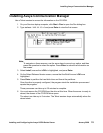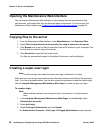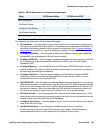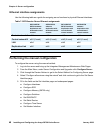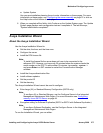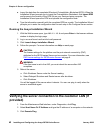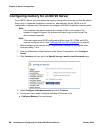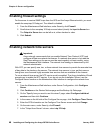
Methods of Configuring a server
Installing and Configuring the Avaya S8700-Series Server January 2008
39
The following describes each of the configuration pages:
● Set Identities — Use this page to assign Avaya server host names and to assign server
functions to a physical Ethernet interface. The options are pre populated with defaults, but
should be changed as needed for the customer’s configuration. See Ethernet interface
assignments on page 40 for a guide to assigning functions to Ethernet interfaces.
● Configure Interfaces — Use this page to enter the IP address, subnet mask, gateway,
and speed for the management LAN and control network.
● Configure ESS/LSP — Use this page to configure the server as either a primary controller
for the system or as an Enterprise Survivable Server (ESS) or a Local Survivable
Processor (LSP).
● Configure Memory — For the S8720 main or ESS server, S8710 ESS server, use this
page to configure the server as either standard or extra large. A server that is configured
as extra large provides higher capacities.
● Configure Switches — Use this page to specify an IP address and optional SNMP
community strings for any Ethernet adjuncts that the Avaya server controls, that are
connected to the server over a private LAN.
● Set DNS/DHCP — Use this page to enable the different devices (endpoints) in your Avaya
call-processing system to communicate over the corporate LAN. Most corporate networks
have one or more domain name service (DNS) servers that associate an IP address with
the name of a device. When you administer the DNS with the Avaya server names, you
can access the servers by name and by IP address over the corporate network.
● Set Static Routes — Use this page only if the network administrator instructs you. If the
administrator does not specify a particular route for the server to send information over the
network, leave the options blank and click Continue.
● Configure Time Server — Use this page to specify the time source that the Avaya server
uses to set the time of day.
● Set Modem Interface — Use this page to enable Avaya services or another
trouble-tracking service to monitor the Avaya server for alarms. Technical-support
representatives can dial in to this interface to fix problems as they occur.
Set DNS/DHCP
3 3
Set Static Routes
33
Configure Time Server
3 3
Set Modem Interface
33
Table 6: S8700-Series Server configuration web pages
Page S8700-series Main S8700-series ESS





